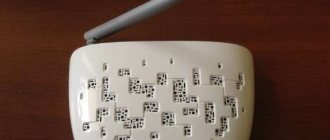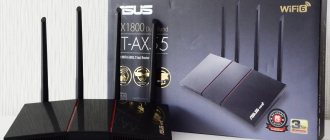In addition to providing Internet access and broadcasting digital television, Rostelecom provides its subscribers with branded universal equipment on a rental basis. Naturally, the communication service provider does not manufacture routers, modems and subscriber terminals. This is done by Chinese manufacturers such as TP-Link, Sagemcom, ZTE, Huawei and some others.
Setting up a Rostelecom router yourself is not difficult. The device comes with a disk containing a special utility for configuring the connection automatically. Users who do not accept automation can use the standard method and configure the equipment via the web interface.
Useful video on step-by-step setup of ADSL routers from Rostelecom:
Next, we will consider all the important points regarding setting up the Internet, television and Wi-Fi.
Reset
Most often, the initial settings of the router are closest to those needed for the smooth operation of the Internet. Just change a couple of points and get started. If you receive a router with broken configurations and don’t want to waste time fixing them, it’s easier to reset them. For this purpose, a special “Reset” button is provided in the case of modern models. As a rule, it is recessed into the body so that you only see the hole with the signature. Take a non-sharp pin, such as a paperclip, and use it to press the button inside the hole. For clarity, in the figure below the button is indicated by the number 1.
Figure 1 – Rear panel of the router
Before connecting for the first time, select the correct location of the router. Do not put it in a closet, do not put it on a distant windowsill. It should be equidistant from all potential uses. Remember, the fewer obstacles, the stronger the router's Wi-Fi signal and the faster the connection.
What problems can a subscriber encounter?
If after connecting the router to the ADSL line the connection disappears, then the reasons for this may be the following:
- device failure (specialists can fix the problem);
- telephone line is broken (just call the support service);
- outstanding payment (make monthly payment);
- error in device parameters.
If you are unable to configure the equipment yourself, you can seek help from a specialist by calling the hotline 88001000800.
Initial connection
The initial connection process is similar for all types of wired routers. Manufacturers try to indicate clear and similar symbols on different models and be sure to indicate detailed instructions in the documentation.
Connection diagram
To set up a Wi-Fi router, first follow the preliminary steps:
- Connect the router's power cable to the electrical outlet and insert it into the “Power” connector on the back panel of the device. In Figure 1, the connector is labeled 2. Make sure that the device operation indicator lights up. As a rule, it is indicated by a classic icon - a line partially or completely inscribed in a circle. For an example of designation, see Figure 2 under number 1.
Figure 2 – Router indicator panel
- Insert the Internet cable into the appropriate connector. It is usually located first, separated from the rest by color, distance and/or frame. Below it is the designation “WAN”, “INTERNET”, “NET”, a drawing of our planet or any other commonly used designation. If everything is done correctly, another indicator will light up on the front panel. It is marked in the same way as the connector. See example designation in Figure 2 under number 4.
If you are connecting an ADSL modem, you will not be able to physically insert the Internet cable into the wrong connector - it differs from the others in size and number of contacts.
- The next step is to connect your computer. You will need a regular network cable. The short version is always supplied with the router. If you don't have enough length to connect, measure and buy, it's inexpensive. Insert one end of the crimped cable into the LAN connector of the computer, and the other into a free connector of the router. Suitable connectors are numbered and highlighted with the word “LAN”. See an example of the designation in Figure 1 under number 4.
- If the router has preset wireless connection settings, the Wi-Fi indicators will also blink. They are indicated by three brackets of different sizes, which are nested within each other. Brackets can be positioned either vertically or horizontally. See example number 2 in Figure 2.
After connecting, proceed to setup. It has its own characteristics for each model and manufacturer, but the general algorithm remains unchanged and is divided into 2 types:
- Automatic setup.
- Manual setting.
There is a third configuration option - using a program installed on your computer. It is usually supplied on disks. But this setup process is a thing of the past.
All common types of Rostelecom routers
These devices can be easily divided into four main types. The separation occurs based on the choice of channel by the router for sending blocks of data in batch mode between different devices.
ADSL modem.
Receiving a signal from telephone networks, it converts it and delivers it to the consumer. A special feature of the router is that in addition to local network connectors for connection, it is equipped with a connector for connecting a telephone.
FTTx modem.
Often used when network data comes over a fiber optic line, and in the home the network runs to the router along paths that are standard distribution cables.
Fiber optic router.
It differs from the above equipment in the way it is connected to the fiber optic network. This happens directly without the need for intermediate intermediate devices. Which is very convenient for Internet users in the private sector.
4G modem.
It does not require laying cables or a fiber optic line, since the network transmission occurs from the nearest station of the network operator. To do this, you need to install a SIM card in the corresponding slot in the modem.
The most common use is an FTTx modem, but its installation requires optical fiber and, in its absence, requires wiring, which is sometimes highly costly.
If there is no cable Internet and it is impossible to install a fiber optic line, the choice falls on a 4G modem. Here, the main criterion for obtaining high-speed Internet is the choice of a cellular operator. You should start from the quality of the network signal and whether the base station is located close to the installation site of the router.
Antennas on the router.
The number of antennas can also affect the coverage area. More often, routers have two, but there are routers with 1 to 6 antennas. Area coverage is influenced by power, radio frequency spectrum, building wall material, and sometimes weather.
Number of port connectors.
The choice must be made based on which devices and how many the user wants to connect.
- Network connectors range from 1 to 4; on the device they are marked with the inscription LAN with numbering. They are needed to connect an IPTV set-top box and to connect directly to a computer.
- IP telephony connector. No more than 2. They are used when connecting to a server or to connect a wireless network to a system complex.
- WAN ports . They are used to connect telephone network paths, the Internet network itself or fiber optics.
- Wireless communication methods. In Russia, radio frequencies in two spectrums are used for high-speed access to the global Internet. One transmits data in the 2.4 GHz range, the other at frequencies equal to 5 GHz. In the second case, data exchange is available using the latest modern methods, transmission channels are wider and, accordingly, fewer unwanted impacts are created for the devices of other network users. Receiving and sending a data packet at a given frequency is carried out at a higher speed. Such advantages also affect the price of the device, which is an order of magnitude higher than a router with the ability to connect in the 2.4 GHz radio frequency spectrum
To independently determine the wave spectrum supported by the device, the user can read the device documentation. The inscription begins with "IEEE 802." and ends in Latin. The letters b, g, n mean the radio wave spectrum of 2.4 GHz. Letters a, ac, ax - the router supports 5GHz radio frequencies
Installing drivers
Modern routers are devices that solve problems independently. Manufacturers have already taught them to communicate with most modern operating systems. Therefore, when connecting a router, you do not need to install any additional drivers on your computer.
The only driver that should be is the driver for the network card. In most cases it is already installed.
Routers have their own software that needs to be updated regularly. This is what is most often meant by the word “driver” in such situations.
Updating the router firmware is simple, but in its own way for each firmware version. Go to the router configuration system; we will describe how to do this after the next subheading. Next, find the section called “Settings” or “Administration”, in it look for the section with the word “Update”. For example, in the screenshot below (Figure 3) the section is called “Firmware Update”. In it, click on the “Check” button, and the system will determine whether a new firmware version has been released. Depending on the result, the page will display a message that no update is required or display a Download button.
Figure 3 – Router configuration system
Updating the router is required for several reasons:
- no program is perfect. During operation, errors and problems encountered by users are identified. The developers are fixing them and including them in the next update;
- Technologies are developing not only in routers, but also in user devices. In smart homes, even bedside lamps, not to mention TVs, work via Wi-Fi. In order for the router to communicate with new devices, programmers write new instructions for it, and you install them.
We recommend that you do not neglect updates and check them at least occasionally.
How to fix crashes
Sometimes equipment breaks down. Let's consider what to do if the Rostelecom device fails:
- Often the cause is a configuration failure. If after rebooting the device nothing has changed, reset the settings.
- A damaged cable may also be the cause. If the wire is broken or pinched, it must be replaced.
- If the wireless network does not work, then you should check your Wi-Fi settings.
- If voltage fluctuations occur in the power supply, the system may also malfunction. In this case, hardware replacement may be necessary.
Setting methods
Before starting setup, go to the web interface of the router firmware. To do this, find the authorization information on one of the sides of the device or on its documentation. It includes the device’s IP address and the login-password pair specified by the developers by default.
In the example below, the authorization data is imprinted on the bottom of the D-Link router:
- IP: 192.168.0.1;
- Login: admin;
- Password: "" (leave the field blank).
Figure 4 – Example of location of authorization data
If the IP address information is nowhere to be found, follow the instructions:
- Open the Start menu.
- Type "cmd" in the Search programs and files box and press Enter.
Figure 5 – entering the CMD command
- Type "ipconfig" in the window that appears and press Enter.
Figure 6 – entering the Ipconfig command
- Remember or copy the numbers next to the “Default Gateway” in the Ethernet connection over the local network.
Figure 7 – determining the gateway IP address
Next, proceed step by step:
- Open any browser.
- Enter the IP address value in the address bar. The required line is indicated by an arrow in the figure below. After successful input, do not forget to press Enter.
Figure 8 – Entering the IP address to enter the settings system
- Enter your login password and click “Login”.
Figure 9 – Entering data to enter the settings system
For security, we recommend changing the standard login and password for logging into the router program.
Automatic setup
Most router manufacturers offer quick setup so you don't waste time entering strange values into unclear fields. You provide a minimum of data and receive a ready-made Internet connection. In some models, it is enough to enter a login, password for an agreement on the provision of Internet access services and data to create a wireless Wi-Fi network.
If the router was provided to you by employees of PJSC Rostelecom, then the settings have probably already been entered in advance and all that remains is to indicate what we described in the previous paragraph.
Let's take a more specific look at the automatic configuration of a router using the example of the proprietary firmware of PJSC Rostelecom:
- After logging in, click "Setup Wizard" in the menu.
Figure 10 – Firmware interface for routers from PJSC Rostelecom
- Next, click “Setup Wizard” twice more, as shown in the figure below and follow further instructions.
Figure 11 – Quick setup
- All that remains is to enter the login and password from the contract. To do this, go to the “Internet Connection” block, enter the data and click “Apply”.
Figure 12 - Quick setup
Any type of router settings for the Rostelecom PJSC network includes entering the following data:
- Login and password. Do not confuse them with the ones you specified earlier to log into the configuration system via a browser. This login and password were given to you by the provider when drawing up the contract. Look for them there. Below we have indicated the place in the document where they should be.
Figure 13 – Where to specify the login and password in the agreement with PJSC Rostelecom
- Network name SSID. An arbitrary value that needs to be entered and remembered.
- Wi-Fi password. This field is called differently, but the essence is the same - come up with a set of characters consisting of letters of the Latin alphabet of different case, numbers and punctuation marks. The final password length must be at least 8.
- Authentication type. Choose the one with the phrase “WPA-2” or “Personal”. This is a standard that determines the level of security when attempts are made to enter your network from outside.
- Encryption. Select "AES". This parameter determines the security of your network when operating subscriber devices that are already logged in.
To start setting up a Wi-Fi wireless connection, follow the route “Network” - “WLAN” - “Basic settings”. Here, enter the SSID as mentioned above. What to set in the remaining columns is everyone’s business. But keep in mind 2 recommendations:
- the wider the channel, the higher its speed, but the greater the likelihood that a neighboring router will interfere with it;
- try to choose the least crowded channel so that the Internet is faster. To do this, install special software on a device with a built-in Wi-Fi module. A laptop or smartphone will do. For the latter, there are a number of applications in the App Store or Play Market. We recommend "WiFi Analyzer".
For example, here are 2 screenshots (Figure 7) from the application. On the right is the network congestion in the standard 2.4 GHz band. The best performance of the router will be if you run it on 12, 13 or 14 channels. If you run it on channel 7, the signal quality will be the worst, because 3 routers will interfere with it at once.
The left side of Figure 7 shows the operation of routers in the 5 GHz band. Dual-band routers operate at such frequencies, which have been sold for a long time, but became affordable only a year or two ago. Apart from the red signal from channels 36 to 165, not a single device works, so you can give your router the right to select any channel.
Figure 14 – analysis of Wi-Fi network congestion
Next, go to the “Network” – “WLAN” – “Security” section. Here, specify the encryption, shared key (password) and WPA mode, as we already described above. The remaining settings are additional; the wireless connection will start without them.
Manual setting
You will have to enter an order of magnitude more information. Before this, log into the firmware management system, as described in the “Setting methods” section.
If you have installed the firmware of PJSC Rostelecom, then:
- Click on the “Network” button in the top menu and on the “WAN” item in the same block of the left menu.
- Scroll to the bottom of the window to the list of “WAN” interfaces. Remove all items from the list using the trash can button on the right next to each item.
- Scroll the window all the way up and enter the data as indicated below:
- default route selection – Specified;
- enable DNS – tick;
- enable NAPT – check mark;
- interface type – pppoe1;
- username, password, connection, downtime, as well as data in the WAN IP, IPv6 WAN and DHCPv6 mode sections are filled in according to the agreement.
After filling, click “Connect”.
Connecting the set-top box to the router
A standard STB receiver (not TV 2.0) does not have a WiFi module and you can only connect the Rostelecom set-top box to the router via an Ethernet port. Here he is:
One of the connectors of the supplied network patch cord is connected to it. On the other hand, it is connected to the LAN port of a WiFi router, ADSL modem or GPON terminal, pre-configured for the service.
There are no difficulties with connecting devices with wires. They appear further when the user tries to set up Rostelecom television on the router in order to include an STB receiver in it. That is why I want to cover this issue separately and in more detail.
Setting up a router port for a TV set-top box
You can’t just plug the receiver into any connector on your router or modem—nothing will work. It must first be configured correctly.
As an example, I will look at one of the most popular routers - D-Link DIR-300. On other models, the web interface will, of course, be different, but the principle of operation itself remains unchanged. Act in the same way and you will succeed! If you have any difficulties, write in the comments - I will try to help!
So, as a rule, in most cases, for the Interactive Digital Television service to work on the router, it is enough to simply separate the port and configure it in bridge mode. On D-Links this is done as easily as possible, through Click'n'Connect or the IPTV Setup Wizard.
We indicate the network connector where the receiver will be connected and apply the changes. Ready!
It’s a little more complicated in cases where you need to additionally specify a virtual network identifier - VLAN ID . This is practiced in many Rostelecom branches. In this case, you must first find out your ID from technical support. Doing this can sometimes be very difficult, due to the fact that the call center that accepts applications is often completely unaware of the situation and it is better to ask immediately to be connected to local support specialists.
After you have found out your Vlan ID for IPTV, write it in the router parameters and bind it to the desired LAN port.
Setting up a D-Link modem for Rostelecom
D-Link offers 3 types of firmware for various router models. In general, the algorithm for setting them up is the same as described in the previous sections. Let's look at it using the DSL-2640U router as an example.
- Open the address 192.168.1.1 in your browser.
- Enter “admin” in the login and password fields.
- Follow the route “Network” – “Connections” – “Add”.
- Enter the data from the agreement in the “Login”, “Password”, “Password Confirmation” and VPI/VCI fields.
- Specify the connection type – PPPoE.
- In the “Service name” column, enter an arbitrary but understandable value.
- O and "IGMP".
Setting up a Rostelecom Intercross ADSL modem
The main difference between an ADSL modem and a regular router is that it uses a telephone channel to transmit data. Without interfering with conversations, ADSL allows you to reach speeds of up to 10 Mbit/second. The technology is being replaced by modern fiber optic communication channels, but is still in use.
Before logging in, reset the settings using the corresponding button on the case. To log in, use the authorization details specified in the previous section.
The appearance of the firmware is outdated, but the inscriptions are clear and distinguishable. There is no Russian interface language. Follow the instructions:
- Click on the "Wizard" button in the top menu. The quick connection setup system will open.
- In the VPI and VCI columns, enter 8 and 35, respectively. Click Next.
- O and “Enable NAT”. Click Next.
- Enter the login and password from the agreement in the “PPP Username” and “Password” columns, respectively. Click "Next" twice.
- To complete the setup, click “Finish”.
What is ADSL technology
Before you start, you need to understand what ADSL technology is and on what principle it works.
A special feature of Rostelecom's ADSL Internet technology is the establishment of communication via telephone wires. Which makes it accessible, even to remote parts of the country. Connecting the Internet from a telephone cable is much easier than connecting, for example, optical fiber. The technology system consists of asynchronous data transfer. At the same time, the speed of received information is much higher than that of transmitted information.
An important point when connecting to the Internet using ADSL technology is to purchase and connect a special splitter to the line. With the help of which, the signal to the phone will not be interrupted when the Internet is turned on, and vice versa. It is a small box into which telephone wires enter and branch out into several possible connections.
The company provides 5 brands of routers:
- ZTE.
- D-Link.
- Sagem [email protected]
- QTECH.
- TP-LINK.
The principle of operation and setting the necessary parameters for connection are not significantly different between them. Therefore, in order to understand how to configure a Rostelecom ADSL technology modem, the principle of operation will be considered using the example of the QTECH QDSL-1040WU Router.
Setting up a TP-Link ADSL modem under Rostelecom
Let's look at the example of TP-Link TD-W8151N. Unlike the previously reviewed models, this one comes with a disk with software for automatically setting up the modem. To configure the network:
- Connect the modem to the computer and Internet cable as indicated in the “Initial connection” chapter.
- Insert the disc into the drive. Make sure it supports reading DVDs.
- Specify the interface language and device model name.
- Follow the instructions and enter the data from the contract.
- To log in, use the standard algorithm described in the previous section.
Routers Rostelecom
In this section, we will look at the main advantages and disadvantages of the models, since not all Rostelecom routers work stably and can provide a high-speed Internet connection.
ADSL . High-speed data transmission method. Produces the final result by demodulating the received signal stream into a digital one. Uses wired telephone networks, which are ubiquitous, unlike fiber optics.
Routers supporting ADSL technology:
xDSL modem ZTE H108N
Main characteristics:
- Connecting via ADSL to the global network
- Access to the Wink interactive TV platform.
- Available connections: 3 set-top boxes.
- Ease of setup.
- 2 year warranty
Advantages : Multifunctional router. Low price.
xDSL router Upvel UR-344
Main characteristics:
- Connecting via ADSL to the global network
- Access to the Wink interactive TV platform.
- Available connections: 3 WINK interactive TV set-top boxes
- Ease of setup
- 2 year warranty
The advantage of this model is its low price and its versatility. The network coverage radius is 100 meters. Quick setup.
FTTH . The most popular technology all over the world. It is used by connecting to an optical fiber, which continues transmission into regular network networks, which in turn are already connected to the router. Compared to telephone lines, it provides a faster connection. We present their characteristics and additional features.
Routers supporting FTTH technology. (FTTx)
Router Rotek RX-22312
Main characteristics:
- Connecting to the global network using FTTx technology
- Supports two RF connection spectrums (2.4 GHz and 5 GHz)
- Optimal when choosing tariffs up to 100 Mbit/s
- Possibility of additional connection of 2 products: Internet and TV set-top box
- Available connections: 3 set-top boxes with access to the Wink interactive TV platform.
- 2 year warranty
Advantages of the model. Connection to networks via fiber optic channels. Supports connection to two network bands.
Router Rotek RX-22200
Main characteristics:
- Connecting to the global network using FTTx technology
- Supports two RF connection spectrums (2.4 GHz and 5 GHz)
- Optimal when choosing tariffs up to 100 Mbit/s
- Connection of 2 products is available: Internet and interactive TV Wink
- Available connections: 3 set-top boxes with access to the Wink interactive TV platform.
- 2 year warranty
Advantages of the model. Connection to networks via fiber optic channels. Supports connection to two network bands.
Router Sercomm S1010
Main characteristics:
- Connecting to the global network using FTTx technology
- Supports two RF connection spectrums (2.4 GHz and 5 GHz)
- Optimal when choosing tariffs up to 100 Mbit/s
- Possibility of additional connection of 2 services simultaneously: Internet, interactive TV Wink
- Available connections: 3 set-top boxes with access to the Wink interactive TV platform.
- 2 year warranty
Advantages of the model. Connection to networks via fiber optic channels. Dual frequency band support.
Gigabit router Iskratel E70
Main characteristics:
- Connecting to the global network using FTTx technology
- Supports two RF connection spectrums (2.4 GHz and 5 GHz)
- High-speed Internet Wi-Fi up to 100 Megabit/s at 2.4 GHz radio frequency spectrum, up to 300 Megabit/s at 5.0 GHz
- Gigabit ports for high-speed packet data transmission.
- Possibility of additional connection of up to 3 products: Internet, interactive TV, home phone
- Available connections: 3 set-top boxes with access to the Wink interactive TV platform.
- 2 year warranty
Advantages of the model. Connection to networks via fiber optic channels. Dual frequency band support. Suitable for tariff plans up to 300Mbits/s.
Gigabit router ZTE H298A
Main characteristics:
- Connecting to the global network using FTTx technology
- Supports two RF connection spectrums (2.4 GHz and 5 GHz)
- High-speed Internet Wi-Fi up to 100 Mbps on the 2.4 GHz radio frequency spectrum, up to 300 Megabit/s on the 5.0 GHz spectrum
- Gigabit ports for high-speed packet data transfer
- Ability to connect up to 3 products: Internet, interactive TV, home phone
- Available connections: 3 set-top boxes with access to the Wink interactive TV platform.
- 2 year warranty
Advantages of the model. Connection to networks via fiber optic channels. Dual frequency band support. Suitable for tariff plans up to 300Mbits/s.
Gigabit router Rotek RX-22311
Main characteristics:
- Connecting to the global network using FTTx technology
- Supports two RF connection spectrums (2.4 GHz and 5 GHz)
- High-speed Internet Wi-Fi up to 100 Mbps in the 2.4 GHz radio frequency spectrum, up to 300 Megabit/s at 5 GHz.
- Gigabit ports for high-speed packet data transfer
- Possibility of additional connection to up to 3 products: Internet, Wink platform and home phone
- Available connections: 3 set-top boxes with access to the Wink interactive TV platform.
- 2 year warranty
Advantages of the model. Connection to networks via fiber optic channels. Dual frequency band support. Suitable for tariff plans up to 300Mbits/s.
Gigabit router Iskratel E80
Main characteristics:
- Connecting to the global network using FTTx technology
- Supports two RF connection spectrums (2.4 GHz and 5 GHz)
- High-speed Wi-Fi up to 100 Mbps in the 2.4 GHz radio frequency spectrum, up to 300 Mbps at - 5.0 GHz
- Gigabit ports for high-speed packet data transfer
- Possibility of additional connection of up to 3 products: Internet, Wink platform and home phone
- Available connections: 3 set-top boxes with access to the Wink interactive TV platform.
- 2 year warranty
Advantages of the model. Connection to networks via fiber optic channels. Dual frequency band support. Suitable for tariff plans up to 300Mbits/s.
All of the above router models are available for purchase on the official website of Rostelecom and in the retail sales network.
These devices have different prices, as well as the ability to support two data transmission frequency ranges, support for USB devices, Voice IP, etc.
Setting up IPTV
All modern router firmware has a separate page or part of it where you can specify IPTV settings. In order for the set-top box to work, it is enough to enter the port number indicated on the back of the router to which the television signal should go. In some firmware, you additionally need to enable IPTV mode.
The IPTV section, as a rule, is located in the same place where the login and password settings from the contract are entered. Look for the corresponding button or heading on the page.
Routers Rostelecom
To make it easier for the user to choose a router, we suggest that you familiarize yourself with what modern connection methods and types are available. Which of our routers are suitable for certain available network connection options.
A router is called routing equipment. It routes and delivers data packets from one device to another. For this purpose, connectors are built into the equipment, when connected to which the Internet is transmitted
When selecting a router, the buyer needs to decide on the purpose and basic necessary parameters of its installation. It is worth paying attention to the main characteristics:
- Types of routers.
- Availability of antennas.
- Ports.
- Supported network standard.











